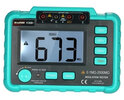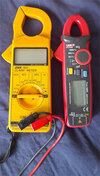I'm more just wondering why he says he could change it then couldn't and gave us this fault.
He seemed really genuine and was a nice bloke
He seemed really genuine and was a nice bloke

Well he can't be accused of ripping you off. Maybe he realised the quote was too low ,and the job was going to be more involved /time consuming than first thought.Hi no.
He said I won't charge you before he left .
He didn't charge for quoting or anything either

I'm surprised it took this many replies to get to this albeit only half hourWith the main switch ON, all Neutrals and Earths are connected together.
That sounds right.If what you say is correct, then another electrician would be a good idea.

That is normal, neutral is linked to earth at the DNO transformer,Long story short with the fuse box switched off there's no neutral to earth fault or continuity, only when the fuse box is on.
Don’t bother. It will (should) be done as part of a CU change.Thanks both.
How much is an EICR test usually ?
Thanks
HiTo clarify to the op
With the main switch OFF, you should not be getting continuity between N and E.
But he should be doing more sophisticated tests.
Has he said which CIRCUIT has the dead short on it? ie lights, sockets etc?
Did he unplug any appliances when doing this 'test'?
There may not be anything with your actual wiring, he should have investigated further.


this is a problem with a new installation as we really have no idea of what equipment will be used, so down to experience, and common practice. But with an existing house it is reasonably easy to measure the back ground leakage, two basic methods, this meterEvery installation shall be divided into circuits, as necessary, to: (iv) reduce the possibility of unwanted tripping of RCDs due to excessive protective conductor currents produced by equipment in normal operation
 measures DC leakage with circuit isolated, and these
measures DC leakage with circuit isolated, and these  meters can measure the AC leakage with the circuits live, we are allowed 1/3 of the rating of the RCD to leak under normal operation so limited to 9 mA with a 30 mA RCD, however over 3.5 mA we need to take special precisions which increases after 10 mA, so really don't want to see over 3.5 mA leakage.
meters can measure the AC leakage with the circuits live, we are allowed 1/3 of the rating of the RCD to leak under normal operation so limited to 9 mA with a 30 mA RCD, however over 3.5 mA we need to take special precisions which increases after 10 mA, so really don't want to see over 3.5 mA leakage.If you need to find a tradesperson to get your job done, please try our local search below, or if you are doing it yourself you can find suppliers local to you.
Select the supplier or trade you require, enter your location to begin your search.
Are you a trade or supplier? You can create your listing free at DIYnot Local
